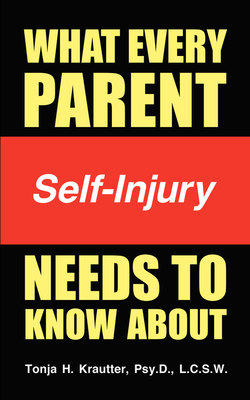Читать книгу What Every Parent Needs to Know About Self-Injury - Tonja Krautter - Страница 13
На сайте Литреса книга снята с продажи.
Is Self-Injury High Risk or Low Risk?
ОглавлениеFor safety reasons, it is important to understand the difference between high-risk and low-risk forms of self-injurious behavior. Safety is always a concern when an individual is self-inflicting bodily harm. However, it is of the greatest concern when the risk level is high. It is imperative to intervene expediently when high-risk behavior is involved, such as in the case of the anonymous caller described previously. Deep lacerations requiring stitches, or third degree burns, are more likely to cause significant trauma or even death than superficial scratches and singed hair follicles.
There are two measures that determine whether a self-injurer is considered high risk or low risk. The first is the type of instrument they use. The second is the place on their body where they self-mutilate. Higher-risk instruments tend to include knives, razors, glass, and fire sources. Lower-risk instruments may include push pins, paperclips, staples, pencils, and rubber bands. Higher-risk body parts typically include wrists, neck, and inner thighs. Lower-risk body parts are generally forearms, upper thighs, stomach, and shoulders.
There are many consequences to higher-risk behavior. The most vital is obviously safety. However, another consequence, which is often overlooked, is scarring. Most self-injurers are left with scars on their body to indicate where they inflicted bodily harm.
Different individuals have different feelings about their scars. Some are embarrassed, some are proud, and some are indifferent. In any case, they are real and often permanent. Nadia writes, “The 400 or so scars on my body weren’t meant to mock me and scream – You Are a Screw Up! Look at you – years later! But this is exactly what they do.” She states, “It is ironic how the very thing that got me through is now the source of so much shame.”
Conversely, Nicole relates, “I am glad I have my scars. They tell a story about my life and are reminders of the struggles I have worked hard to overcome.” She is not ashamed or embarrassed about her scars and does not want them to fade. She states, “Losing my scars would be like losing a part of myself.”
Joey is indifferent to his scars. He says, “I am not ashamed and I am not proud of them. They are what they are and there is nothing I can do to change that. I knew I would be marking my body every time I chose to self-injure so I don’t concern myself with the scars now.”
Parents have their own feelings about their child’s scars. Most do not like to look at them and are devastated by what their child has done to herself. Parents often blame themselves that they let things get this far without knowledge or intervention. They worry that others will be quick to criticize, blame, and/or label if the scars are noticed. Therefore, parents often want to hide their children’s scars from others.
The individual struggling with self-injury recognizes how frightened, horrified, and even disgusted their parents often are when they see the damage that they have done to their skin. They are easily able to recognize when a parent is embarassed and ashamed of their actions. Although this may be a understandable parental reaction and a predictable consequence for the person engaging in self-injurious behavior, it is extremely upsetting to the person who is struggling with the problem.
Parents often try to hide their child’s problem with self-injury from others. Many are invested in keeping this a secret from others (see chapter 3 for more details). A big part of covering up the problem is covering up their child’s scars. When parents go to great lengths to hide the problem from others (even when well-intentioned), it can make the individual feel worthless, unloved, and unsupported. Many of my patients report that they feel like a disappointment to their parents and that they are “not good enough” in their parents’ eyes.
The following poem illustrates one patient’s feelings about her scars and her parents’ response to this very visible reminder of her struggles:
